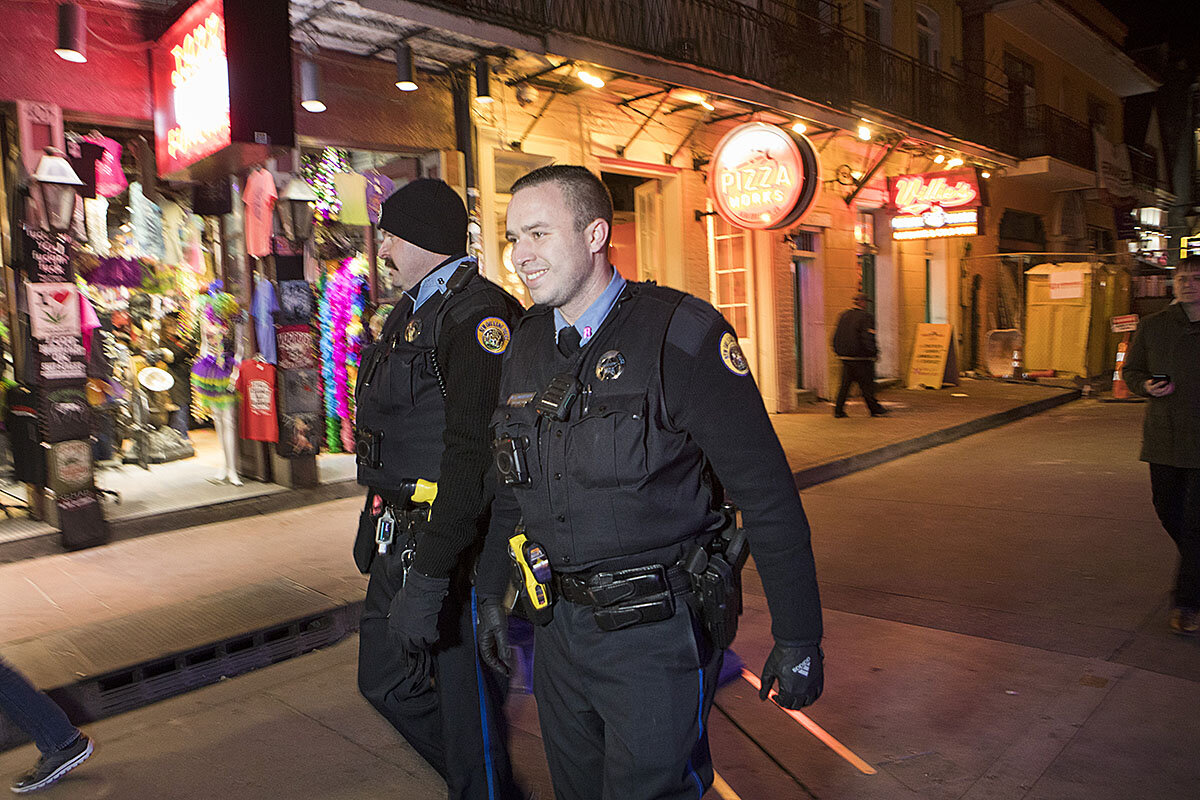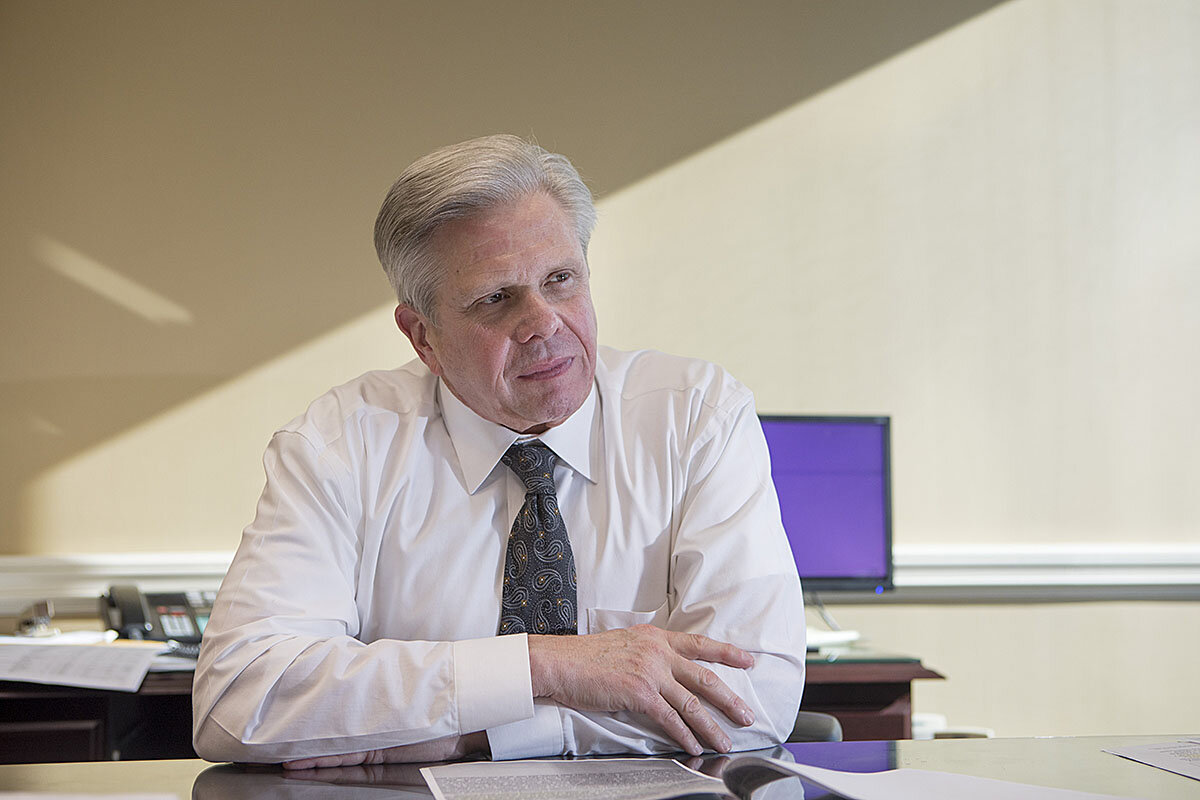How New Orleans police went from ‘most corrupt’ to model force
Loading...
| New Orleans
On patrol down Bourbon Street, dodging broken Mardi Gras necklaces, New Orleans police officer Patrick MacFarlane spots a back-packer with gray clothes, a walking stick, dusty beard.
Officer MacFarlane, a tall Jersey Shore native with a chevron moustache, approaches alongside his partner, William McGeever.
They talk intently. The man gestures wanly. MacFarlane cocks his head. “OK, be safe,” the officer says. The man wanders off – another down-on-their-luck American living just beyond the edge of the neon.
Why We Wrote This
Can the federal government really fix corruption in police departments, or do federal monitors increase crime by lowering officer morale? New Orleans – once known as the most abusive cop shop in the US – shows that lasting reform is possible.
Far from looking for a vagrancy arrest to keep the riffraff away from the tourists, MacFarlane explains that he inquired about the man’s trusty dog, which had apparently been stolen while he slept. MacFarlane asked whether he needed help making a police report. The man demurred.
“It is a gumbo out here – we get people from all over the world – so we treat every situation according to what it needs,” says MacFarlane, who walks one of America’s oldest foot patrol beats.
“If there is obvious criminality, we make an arrest,” says Officer McGeever. “But in a lot of cases, we look for other ways to resolve the situation.”
It is a small moment but it speaks volumes in New Orleans, a city whose police department less than a decade ago ranked as America’s most corrupt, according to Tom Perez, the former assistant attorney general for civil rights at the US Department of Justice.
After all, New Orleans sent two police officers from the precinct to death row after they orchestrated a murder. Until recently, some officers here double-dipped as muscle for drug kingpins. A local jail was known on the street as “the glue factory” for its brutal treatment of prisoners.
Yet today, with officers like MacFarlane and McGeever on the front lines, the NOPD, overseen by a federal monitor, has, against all odds, become a pioneer in humanistic policing.
There is genuine outreach to the LGBTQ community. MacFarlane is part of a new program that helps homeless people transition from the streets without mandating sobriety. And then there is a peer intervention program called EPIC – Ethical Policing Is Courageous. Based on the idea that greater accountability builds camaraderie and strengthens the chain of command, it allows lower ranking officers to confront higher ranking ones about their actions without fear of retaliation. EPIC is now being utilized in over three dozen departments. The FBI includes it in instruction at Quantico.
In January, US district Judge Susie Morgan called the city’s progress over the past five years “remarkable.”
To be sure, the city may still be years away from exiting a 2013 consent decree that has cost taxpayers $55 million so far. With nearly 500 action items, it is the biggest consent decree in US history.
But there is little doubt that New Orleans has become a critical keystone in a broader debate about how America’s police should be policed – and the extent to which national priorities should be set locally against broader concerns about ethics and constitutional abuses.
“I compare what was going on in New Orleans with the police to domestic violence: You would have these terrible eruptions of violence, off the charts, and then there would be flowers and candy: ‘We’re so sorry, we’re going to fix it,’ ” says Mary Howell, who has worked as an attorney in New Orleans since 1977. “But nothing would really change. Now, there has been a transformation here, and the question is, can it be exported and will it continue in other places?”
A tool for justice
Consent decrees were established by the Violent Crime Control and Law Enforcement Act of 1994. The contracts impose court oversight to correct indisputable patterns of civil rights abuses by police against civilians, often with racial overtones.
Los Angeles spent eight years under a consent decree after a squad of officers were found running drugs. A number of other cities – Cincinnati, Cleveland, and Ferguson, Mo. – have undergone a hard look at their inner workings from the outside. Police officers point out these are often in areas where officers work in dangerous environments, sometimes for low pay and even less gratitude.
Sometimes effective, sometimes not, consent decrees embody a national debate over whether to use federal muscle to create local change in policing.
Under Attorney General Eric Holder, the Obama administration entered into a record 14 consent decrees amid a national uproar over the deaths of unarmed black men by police. A report last fall from the US Commission on Civil Rights found stubborn racial disparities in use of force across the United States.
The Trump administration has responded differently, imposing no consent decrees in the past two years. Upon his departure this past fall, former Attorney General Jeff Sessions issued a memo that narrowed their scope and length, blaming them for lowering officer morale and handcuffing the ability of officers to fight crime. In a foreword to a critical 2008 study by the Alabama Policy Institute, Mr. Sessions called such decrees one of the “most dangerous ... exercises of raw power” and an “end run around the democratic process.”
Opposition to such decrees is widespread. Some cops, like former NOPD homicide chief Jimmy Keen, argue they can embolden criminal activity. Rafael Goyeneche III, who monitors police corruption at the Metropolitan Crime Commission, has also begun to push to close the decree, saying it is consuming too many resources.
Yet the dramatic shift away from consent decrees by the Trump administration has left troubled departments like Elkhart, Ind., and Little Rock, Ark., with little motivation to reform, policing experts say.
“It has not escaped my attention that we have not seen numbers on police shootings decrease at all over the past few years,” says Christy Lopez, a primary author of the “Ferguson Report” and a professor at Georgetown Law. “The prospect of a federal investigation has been a really important incentive [for PDs to reform], but that incentive has now been decreased.”
New Orleans, for one, failed to stem corruption without federal help.
In the late 1990s, then-Mayor Marc Morial introduced local reforms to stave off a consent decree, including the firing of hundreds of problematic police officers. After he left in the early 2000s, the reforms floundered. Mr. Morial has since publicly second-guessed his opposition.
Not long after his departure, NOPD officers shot a famous trombonist, Joe Williams, in 2004, and then attacked a tribe of Mardi Gras Indians, whose leader, a local folk hero, subsequently died while speaking at a public hearing about the incident. By the time hurricane Katrina flooded the city in 2005, not just the reforms, but the “whole system had collapsed,” says Ms. Howell, the New Orleans lawyer and civil rights advocate.
A cover-up of the murder of civilians on Danziger Bridge after the storm became the impetus for the current consent decree.
“The NOPD has long been a troubled agency,” a report introducing the decree in 2013 read. “Basic elements of effective policing – clear policies, training, accountability, and confidence of the citizenry – have been absent for years.”
Though many cops grumbled, this time the city and its leadership was ready for some federal tough love.
The consent decree “forced the department to do something it was incapable of doing on its own,” says Peter Scharf, a criminologist at Louisiana State University. “It had to change its culture and its values, because good cops were paying the price for the bad.”
At first, as Sessions and others warned, morale plummeted, observers say. Yet leaders persisted while measuring the effects with citizen surveys.
As Judge Morgan noted in January the city also went above and beyond the requirements of the decree with the EPIC program. Its detectives were the first to work with the Innocence Project to curb wrongful convictions, of which the city has had so many that there is an annual banquet for freed citizens.
The shifts have been dramatic. Serious use of force by officers has plummeted from 14 in 2013 to 1 last year. In surveys, the percentage of people whose interactions with police were described as pleasant and courteous rose from 53 percent in 2009 to 87 percent a decade later.
Monitors also found a correlation between public opinion of the police and the violent crime rate. Though violent crime remains high for a city of its size, the 2018 homicide rate was 146, a 47-year low.
“Constitutional and effective policing go hand in hand,” the DOJ’s Jude Volek told a hearing on Jan. 25.
And in 2018, NOPD saw the fewest officer-involved shootings since before the consent decree was implemented: four. One of the shootings involved an animal and three were accidental shootings.
Today, the department wears the turnaround like a badge.
“NOPD is proud of this recognition of its remarkable transformation into a model of reform,” says Daniel Murphy, the NOPD’s deputy compliance chief, in an email. The city is “committed to ... further elevating its status as a leader in 21st century policing.”
Going forward
The big question now is whether the progress can be sustained.
Police Superintendent Michael Harrison has been widely credited for pushing the department over the hump, arguing that what he called “the blue wall of silence” around problems had stymied reforms and ruined public trust.
Mr. Harrison left in January to take the same position in Baltimore, another violence-scarred US city under a DOJ consent decree, imposed after the death of Freddie Gray.
In January, new Police Superintendent Shaun Ferguson vowed, “We will go forward. Will refuse – and will not – go backward.”
Back on Bourbon Street, it’s a quiet night. MacFarlane appeals to a group of balcony revelers to not toss beads on the street.
He bows as a wedding party walks by and notes that a highlight of his job is being asked by bridesmaids to be in a picture. “If my wife ever looked on Facebook, she’d be shocked,” he laughs. “Luckily, she has a sense of humor.”
New Orleans still struggles, according to the federal monitor, to recruit police officers well-versed in constitutional policing. But thanks to ongoing efforts and beefed-up training, MacFarlane and McGeever now have a chance to make their imprint on a storied, and troubled, city.
Their Bourbon Street example of constitutional policing “is a nice encapsulation of a department that has gone from warrior to guardian, and where people who have historically felt heavily policed feel like they can come to the police for help,” says Professor Lopez, who as deputy chief of DOJ’s Civil Rights Division oversaw several key consent decrees, including in the Crescent City.
“It is a huge sea change for New Orleans.”








